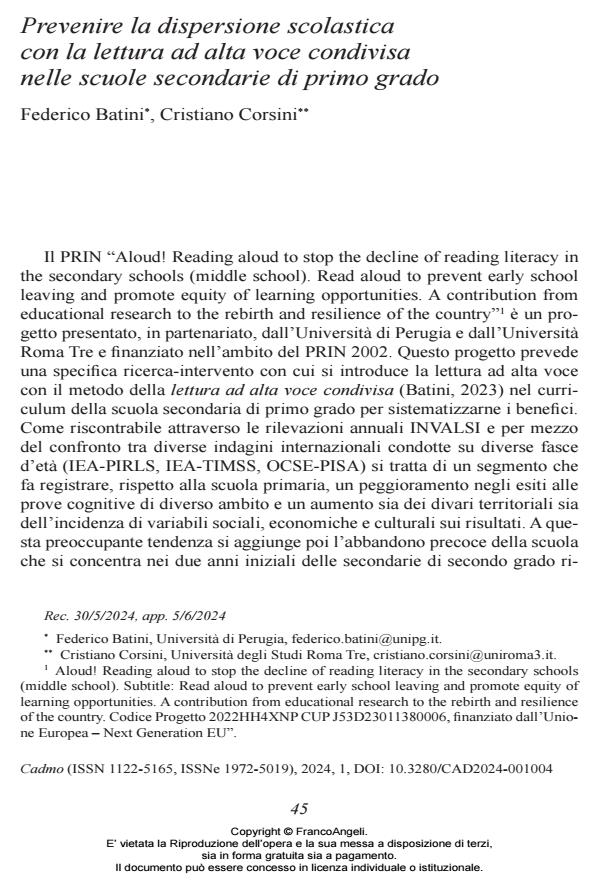Prevenire la dispersione scolastica con la lettura ad alta voce condivisa nelle scuole secondarie di primo grado
Titolo Rivista CADMO
Autori/Curatori Federico Batini, Cristiano Corsini
Anno di pubblicazione 2024 Fascicolo 2024/1
Lingua Italiano Numero pagine 16 P. 45-60 Dimensione file 221 KB
DOI 10.3280/CAD2024-001004
Il DOI è il codice a barre della proprietà intellettuale: per saperne di più
clicca qui
Qui sotto puoi vedere in anteprima la prima pagina di questo articolo.
Se questo articolo ti interessa, lo puoi acquistare (e scaricare in formato pdf) seguendo le facili indicazioni per acquistare il download credit. Acquista Download Credits per scaricare questo Articolo in formato PDF

FrancoAngeli è membro della Publishers International Linking Association, Inc (PILA)associazione indipendente e non profit per facilitare (attraverso i servizi tecnologici implementati da CrossRef.org) l’accesso degli studiosi ai contenuti digitali nelle pubblicazioni professionali e scientifiche
This study investigates the impact of shared reading aloud on preventing school dropout in middle schools, specifically targeting students aged 11 to 14. The research is part of the Prin “Aloud! Reading aloud to stop the decline of reading literacy in the secondary schools (middle school). Read aloud to prevent early school leaving and promote equity of learning opportunities. A contribution from educational research to the rebirth and resilience of the country”, a collaboration between the University of Perugia and Roma Tre University. The project aims to integrate shared reading aloud into the middle school curriculum to enhance literacy and cognitive skills, thereby reducing early school leaving and promoting educational equity. The research employs a quasi-experimental design involving 36 classes (approximately 900 students) randomly assigned to either an intervention or a control group. In the intervention group, 80 hours of curriculum time are dedicated to reading aloud narrative fiction, while the control group continues with regular academic activities. Teachers in the intervention group receive intensive training on shared reading aloud method. The project’s broader goal is to demonstrate that systematic and intensive reading aloud can enhance educational outcomes and prevent school dropout, particularly in socioeconomically disadvantaged areas. The preliminary findings support the integration of shared reading aloud into educational practices to foster a more equitable learning environment and promote long-term academic success.
Parole chiave:shared reading aloud, preventing dropout in middle school, reinforcing literacy for school success, effects and benefits of shared read aloud stories from 11 to 14 years old, empowerment through shared reading aloud.
Federico Batini, Cristiano Corsini, Prevenire la dispersione scolastica con la lettura ad alta voce condivisa nelle scuole secondarie di primo grado in "CADMO" 1/2024, pp 45-60, DOI: 10.3280/CAD2024-001004